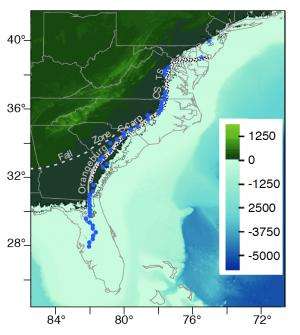The reconstructed shoreline of the eastern U.S. at 3 million years ago (colors represent topography in meters). The reconstruction is based on mantle flow and glacial isostatic adjustment over the past 3 million years. The predicted shoreline is in good agreement with geologic inferences which has implications on understanding the past long-term sea level change.
(Phys.org) —The distortion of the ancient shoreline and flooding surface of the U.S. Atlantic Coastal Plain are the direct result of fluctuations in topography in the region and could have implications on understanding long-term climate change, according to a new study.
Sedimentary rocks from Virginia through Florida show marine flooding during the mid-Pliocene Epoch, which correlates to approximately 4 million years ago. Several wave-cut scarps, (rock exposures) which originally would have been horizontal, are now draped over a warped surface with up to 60 meters variation.
Nathan Simmons of Lawrence Livermore National Laboratory and colleagues from the University of Chicago, Université du Québec à Montréal, Syracuse University, Harvard University and the University of Texas at Austin modeled the active topography using mantle convection simulations that predict the amplitude and broad spatial distribution of this distortion. The results imply that dynamic topography and, to a lesser extent, glacial adjustment, account for the current architecture of the coastal plain and nearby shelf.
The results appear in the May 16 edition of Science Express, and will appear at a later date in Science magazine,
"Our simulations of dynamic topography of the Eastern Seaboard have implications for inferences of global long-term sea-level change," Simmons said.
The eastern coast of the United States is considered an archetypal Atlantic-type or passive-type continental margin.
"The highlight is that mantle flow is a major component in distorting the Earth's surface over geologic time, even in so-called 'passive' continental margins," Simmons said. "Reconstructing long-term global sea-level change based on stratigraphic relations must account for this effect. In other words, did the water level change or did the ground move? This could have implications on understanding very long-term climate change."
The mantle is not a passive player in determining long-term sea level changes. Mantle flow influences surface topography, through perturbations of the dynamic topography, in a manner that varies both spatially and temporally. As a result, it is it difficult to invert for the global long-term sea level signal and, in turn, the size of the Antarctic Ice Sheet, using east coast shoreline data.
Simmons said the new results provide another powerful piece of evidence that mantle flow is intimately involved in shaping the Earth's surface and must be considered when attempting to unravel numerous long-term Earth processes such as sea-level variations over millions of years.
More information: "Dynamic Topography Change of the Eastern United States Since 3 Million Years Ago," by D.B. Rowley et al. Science Express, 2013.
Journal information: Science Express , Science
Provided by Lawrence Livermore National Laboratory






















